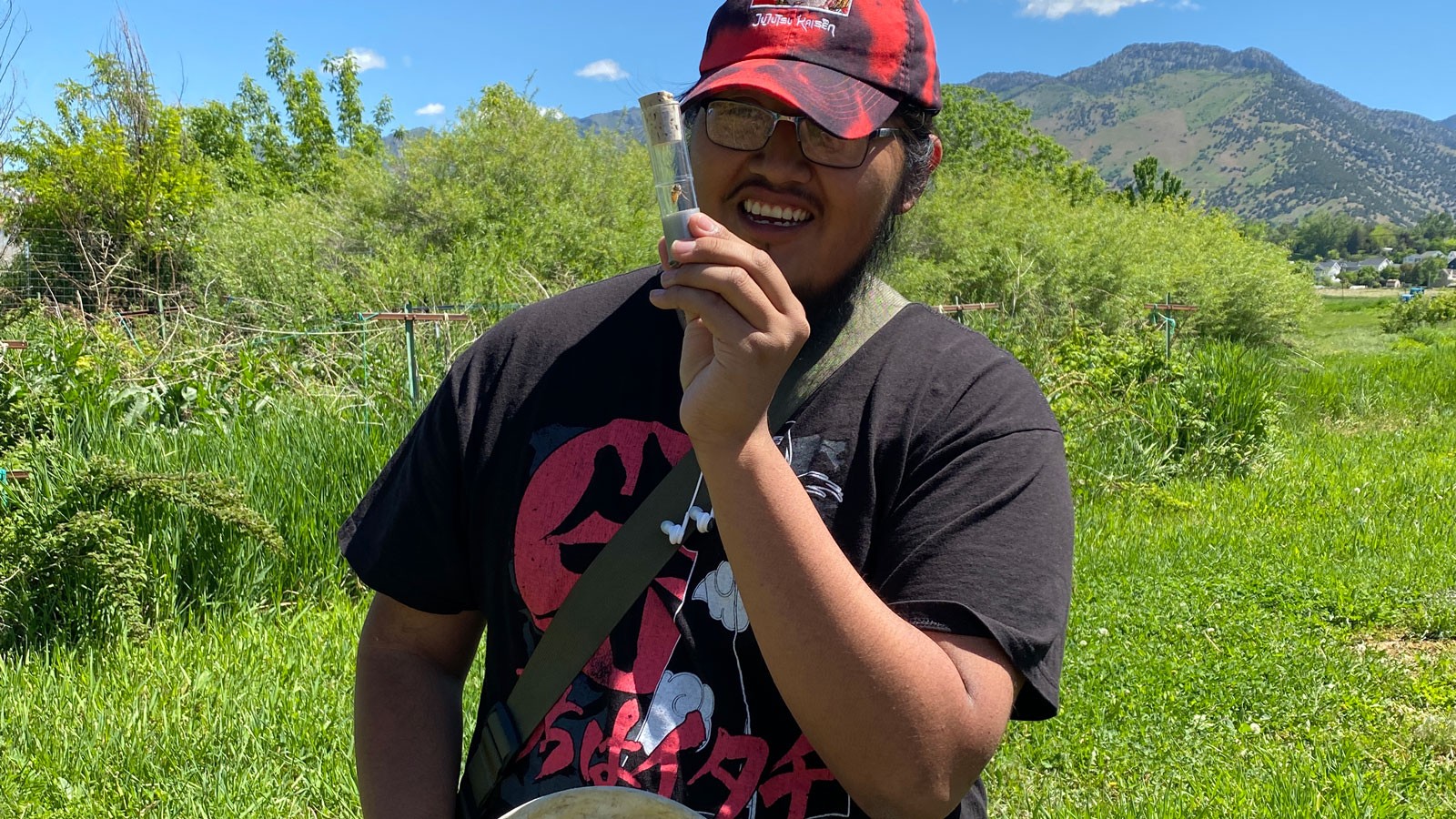To 'Bee' or Not to 'Bee': USU Researchers Test AI Method for Pollinator Identification
Participants in USU's 2022 Native American Summer Mentorship Program to present research projects Tuesday, June 14.
By Mary-Ann Muffoletto |
USU Blanding undergrad Rex Harvey inspects a bee he net-collected at the USDA-ARS Pollinating Insect Research Unit Experimental Research Garden in Cache Valley. Harvey and fellow NASMP scholars present research Tuesday, June 14. (J. Koch photo)
Humans, along with other organisms that inhabit the Earth, depend on bees and other pollinators to survive. Bees pollinate most of our food crops and feed for livestock, and also contribute to healthy ecosystems. But we haven’t made it easy for these tiny insects, which face decline from climate change, habitat loss, pesticides and other human-caused factors.
Bee management and conservation, says Jonathan Koch, a research entomologist with the Utah State University-based USDA-ARS Pollinating Insect Research Unit, depend on accurate identification of bee species. He and other researchers are turning to advances in artificial intelligence image classification to make that task more efficient, more cost-effective and less invasive for bees.
To investigate software programs using this technology, Koch enlisted help from USU Blanding undergraduate Rex Harvey, a participant in USU’s 2022 Native American Summer Mentorship Program. Harvey, Koch and other students from Koch’s lab have visited seven field sites in Cache Valley and Logan Canyon within the past month to capture images of bees and test varied software programs’ abilities to accurately identify the pollinators. The team also used nets to capture bees, which they brought back to the lab for DNA analysis. They’re comparing the DNA identification findings with the image identification results of the software programs.
“I’ve really enjoyed this project, because I got to spend so much time outdoors exploring this area,” says Harvey, who is from Montezuma Creek in southeastern Utah. “This is a perfect time of year because everything is so green.”
Harvey is among nine USU Blanding Aggies who’ve traveled to Logan to participate in the university’s NASMP program. Initiated in 2014, NASMP provides an immersive introduction to four-year degree programs in a wide variety of disciplines. During their monthlong stay in Cache Valley, which started June 4 this year, students participated in campus tours, team-building activities including the USU Ropes Course, as well as research projects ranging from understanding climate variability across spatial scales to how rainstorms can generate hazardous flash floods and how an invasive reed called phragmites is wreaking havoc with Great Salt Lake wetlands.
Harvey, who is completing an associate degree and plans to study electrical engineering, says Koch’s project introduced him to bee-catching and insect image capture in the field, as well as pipetting and DNA extraction in the lab.
“I never thought about how long it takes to get a really good, usable photo of a bug,” he says. “I’ve learned that research takes a lot of time, and sometimes a wrench gets thrown into the works, and you have to start over.”
His mentor, Koch, says many people have the impression that scientists always know exactly what they’re doing and make discoveries “every day.”
“That’s not how it works,” says Koch, a USU alum (MS’11, Biology; Ph.D.’15, Ecology) and adjunct research assistant professor in the Department of Biology. “A colleague of mine wisely says we call it ‘research’ instead of ‘search,’ because we have to redo things over and over. It’s a long process to gain knowledge.”
Still, Harvey looks forward to new discoveries as he continues his education.
“I think it would be exciting to develop new technology, a new material or new software,” he says. “I’d like to study new sources of energy that are less damaging to the planet.”
Harvey and his fellow NASMP participants will share their research experiences from 9-10:30 a.m. Tuesday, June 14, in Old Main Room 121. All are welcome.
Biology/Ecology doctoral student Hannah Wilson serves as lead facilitator for the 2022 NASMP program, with assistance from fellow facilitators and Biology/Ecology doctoral students Savannah Atkins and Jessica Murray, as well as Instructional Technology and Learning Sciences graduate research assistants Siyu Wu and AlLisia Dawkins.
WRITER
Mary-Ann Muffoletto
Public Relations Specialist
College of Science
435-797-3517
maryann.muffoletto@usu.edu
CONTACT
Hannah Wilson
Lead Facilitator
Native American Summer Mentorship Program
hannah.wilson@usu.edu
TOPICS
Diversity & Inclusion 251stories Hands-on Learning 208stories STEM 161stories Wildlife 141stories Bees 27storiesComments and questions regarding this article may be directed to the contact person listed on this page.







